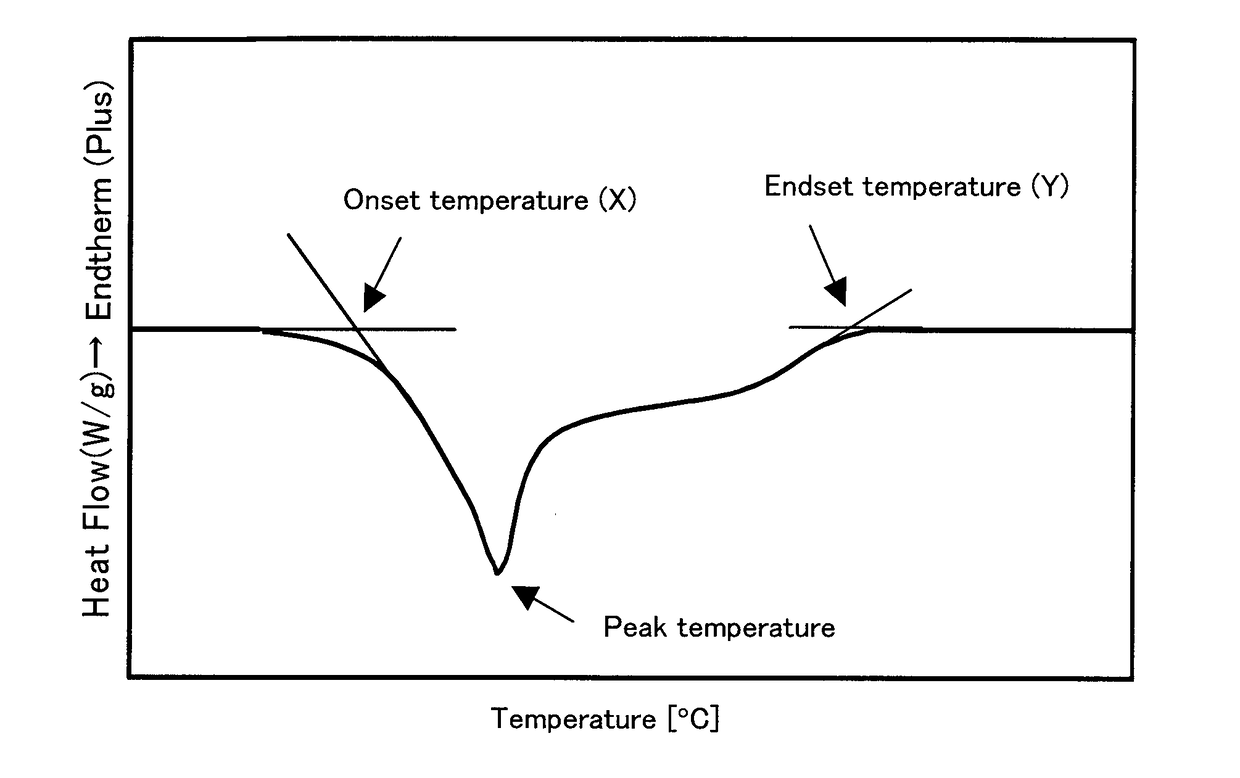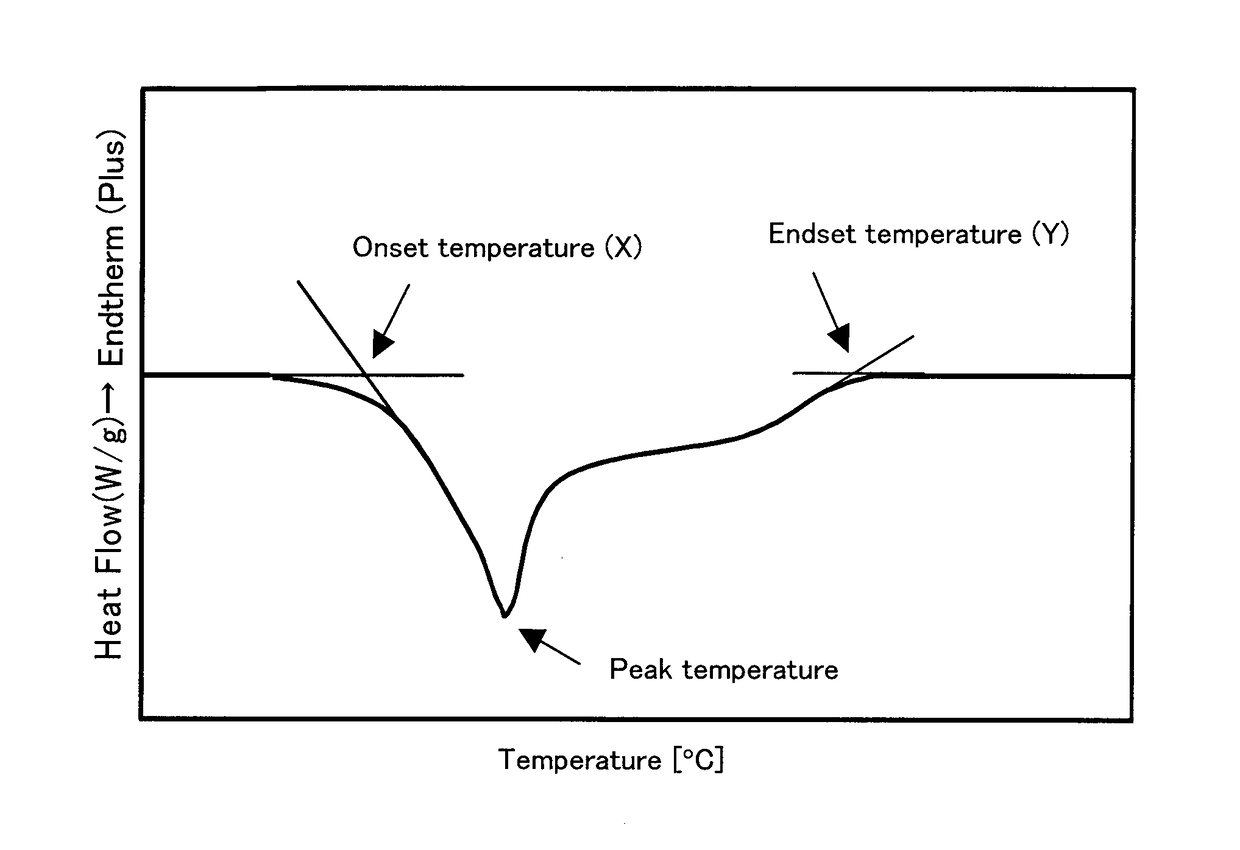Toner and developer
a technology applied in the field of toner and developer, can solve the problems of high energy requirements for fixing, difficulty in obtaining smaller particle diameters of toner by such a method, and toner obtained by this method, and achieves excellent low temperature fixing ability, high quality, desirable offset resistance
- Summary
- Abstract
- Description
- Claims
- Application Information
AI Technical Summary
Benefits of technology
Problems solved by technology
Method used
Image
Examples
production example 1
—Synthesis of Crystalline Polyester Resin 1—
[0306]A 5 L four-neck flask equipped with a nitrogen-introducing pipe, a drainpipe, a stirrer and a thermocouple was charged with 2,500 g of 1,12-decanediol, 2,330 g of 1,8-octanedioic acid, and 2.9 g of hydroquinone, and the mixture was allowed to for 30 hours at 180° C., then for 10 hours at 200° C., followed by reacting for 15 hours at 8.3 kPa to thereby synthesize Crystalline Polyester Resin 1.
[0307]The obtained Crystalline Polyester Resin 1 was subjected to the measurements of a melting point, a weight average molecular weight (Mw), a proportion thereof having the number average molecular weight (Mn) of 500 or smaller, a proportion thereof having the number average molecular weight (Mn) of 1,000 or smaller, an acid value, and a hydroxyl value. The results are shown in Table 1.
production example 2
—Synthesis of Crystalline Polyester Resin 2—
[0308]A 5 L four-neck flask equipped with a nitrogen-introducing pipe, a drainpipe, a stirrer and a thermocouple was charged with 2,500 g of 1,12-decanediol, 2,330 g of 1,8-octanedioic acid, and 6.9 g of hydroquinone, and the mixture was allowed to react for 10 hours at 180° C., and then the mixture was heated to 200° C. and reacted for 4 hours, followed by reacting for 5 hours at 8.3 kPa to thereby Synthesize Crystalline Polyester Resin 2.
[0309]The obtained Crystalline Polyester Resin 2 was subjected to the measurements of a melting point, a weight average molecular weight (Mw), a proportion thereof having the number average molecular weight (Mn) of 500 or smaller, a proportion thereof having the number average molecular weight (Mn) of 1,000 or smaller, an acid value, and a hydroxyl value. The results are shown in Table 1.
production example 3
—Synthesis of Crystalline Polyester Resin 3—
[0310]A 5 L four-neck flask equipped with a nitrogen-introducing pipe, a drainpipe, a stirrer and a thermocouple was charged with 2,500 g of 1,12-decanediol, 2,330 g of 1,8-octanedioic acid, and 8.9 g of hydroquinone, and the mixture was allowed to react for 6 hours at 180° C., and then the mixture was heated to 200° C. and reacted for 3 hours, followed by reacting for 4 hours at 8.3 kPa to thereby Synthesize Crystalline Polyester Resin 3.
[0311]The obtained Crystalline Polyester Resin 3 was subjected to the measurements of a melting point, a weight average molecular weight (Mw), a proportion thereof having the number average molecular weight (Mn) of 500 or smaller, a proportion thereof having the number average molecular weight (Mn) of 1,000 or smaller, an acid value, and a hydroxyl value. The results are shown in Table 1.
PUM
| Property | Measurement | Unit |
|---|---|---|
| melting point | aaaaa | aaaaa |
| acid value | aaaaa | aaaaa |
| melting point | aaaaa | aaaaa |
Abstract
Description
Claims
Application Information
 Login to View More
Login to View More - R&D
- Intellectual Property
- Life Sciences
- Materials
- Tech Scout
- Unparalleled Data Quality
- Higher Quality Content
- 60% Fewer Hallucinations
Browse by: Latest US Patents, China's latest patents, Technical Efficacy Thesaurus, Application Domain, Technology Topic, Popular Technical Reports.
© 2025 PatSnap. All rights reserved.Legal|Privacy policy|Modern Slavery Act Transparency Statement|Sitemap|About US| Contact US: help@patsnap.com


